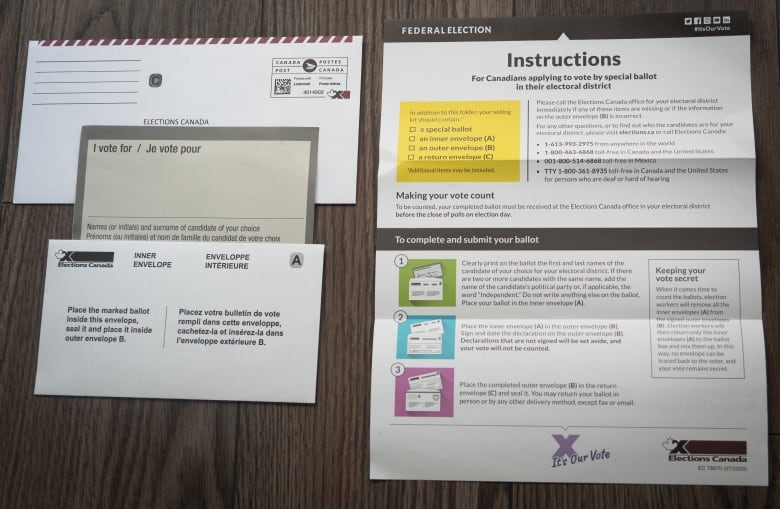
This story came from an audience member, like you, who got in touch with us. Send us your federal election questions and story tips. We are listening: ask@cbc.ca.
The pandemic has changed the way we do just about everything, and elections are no different — especially when it comes to post-secondary students.
Elections Canada scrapped the Vote on Campus program for this year’s federal election because of logistical reasons. The agency told CBC News it made the decision after “assessing the particular challenges of delivering this program in a pandemic environment,” but will “deliver it at future elections.”
Until that happens, here’s how students can exercise their democratic muscle.
- Have an election question for CBC News? Email ask@cbc.ca. Your input helps inform our coverage.
Special ballots for a busy schedule
Many post-secondary students — and their parents — wrote to us asking how they can cast a ballot while away at school.
You’ll want to familiarize yourself with special ballots. It offers the most flexibility to vote with a busy student schedule.
The special ballot system is typically used by people who want to vote by mail or before election day at their local Elections Canada office, but it also works great for students.
If you do choose to vote with a special ballot, you’ll want to apply for one as soon as possible. The deadline to apply is 6 p.m. ET on Sept. 14.
Once your special ballot application is accepted, you will receive a voting kit. It should include everything you need to mail in your vote and instructions on how to mark your ballot.

If you’re attending school abroad you can apply at any time to be part of the International Register of Electors.
If your application is accepted, your special ballot will be the only way you can cast a vote — whether you are at home or abroad. If you try to vote using a regular ballot on election day or at an advance poll, it won’t be counted.
Which riding am I voting in?
Students also wanted to know if they should be casting their ballot from their home riding or their school’s riding.
The short answer is either one, as long as you can prove you live there.
Sanjay Jeram, a senior lecturer in the political science department at Simon Fraser University discusses student voting in the 2021 federal election. 1:18
When you vote by special ballot you will be voting for a candidate in whichever riding you consider your home riding to be. Which means as long as you have the ID to prove it, you can either vote in the riding where you study or where you live when you’re not at school.
It’s important to note that when voting by special ballot you won’t be checking a box. Instead you’ll be hand writing in the first and last name of the candidate you want to vote for to be the Member of Parliament in your riding, so be prepared to remember their name.
If you misspell the name of the candidate, it will be up to the deputy returning officer to determine whether or not your vote will count.
In-person voting options
There are also a few ways to get off campus and vote in person.
Just like any other elector, students can vote at an assigned polling station on Sept. 20, or at advance polls from Sept. 10-13. This process shouldn’t be any different for students.
You can find out more information on exactly where your election day and advance polls will be held here.
-
Use Vote Compass to compare the party platforms with your views.
-
Find out who’s ahead in the latest polls with our Poll Tracker.
Those who are away from home also have the option to travel back to their home riding to vote at their advance or election day polls there, according to Elections Canada. Just make sure you are following your local public health guidelines when travelling within Canada.
You can also vote by special ballot in person at any one of the over 500 Elections Canada offices, which are set up across all 338 ridings. The deadline to do this is the same for applying for a special ballot, which is 6 p.m. ET on Sept. 14.
Forms of ID for students
No matter how you vote, you will need identification to prove that you live in the riding you’ll be voting in.
You can use a driver’s licence or any other card issued by a federal, provincial or local Canadian government, as long as it has your photo, name and current address. You can also use any two pieces of these IDs to vote.
If you have recently moved to a student residence and are concerned about proving your new address, Elections Canada says you can request a letter of confirmation of residence from your university or college. This can be combined with any other accepted proof of ID they may have, including a student card, debit or credit card, or library card.
Figuring out who to vote for
Now that you know which ID to bring, where to bring it and how to vote by mail you’re ready to graduate from student voting 101.
The last piece of the puzzle is figuring out who to vote for. You can try out CBC’s Vote Compass to see where you fall on the political spectrum and what issues matter to you the most.
Do you have a question about the federal election? Send it to ask@cbc.ca or leave it in the comments. We’re answering as many as we can leading up to election day.













